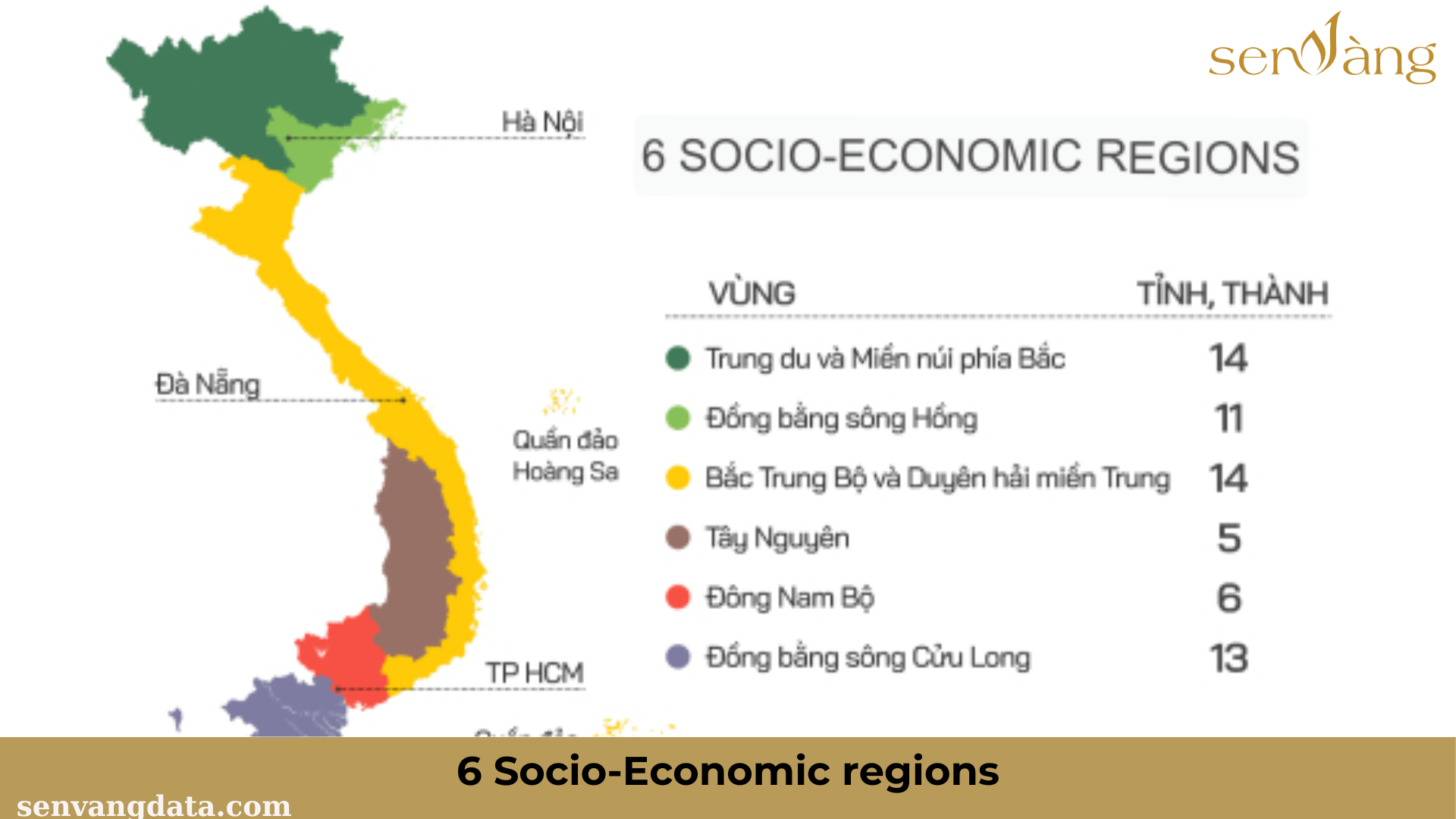The North Central region and Central Coast – a land full of potential with diverse and rich natural resources. The North Central and Central Coast region is an area consisting of 14 coastal provinces, accounting for 50% of the country’s coastal provinces with a length of 1,800km (accounting for nearly 60% of the country’s coastline. The region has a total area of 95,848 km). km2 (accounting for 28.9% of the country’s area), with a population of 20.65 million people, accounting for 20.76% of the country (by 2022).
These geographical features and natural resources are creating diverse development opportunities for the region, from economy to tourism, from agriculture to industry. However, to fully exploit this potential, monitoring and evaluating socio-economic indicators is extremely necessary, in order to shape a specific and sustainable development direction for this region.
Let’s learn about Sen Vang Group in the article belowImportant socio-economic indicators of provinces and cities in the North Central and Central Coast regions todayto help investor and real estate businesses have a more general view of the region!

Source: Compiled by Sen Vang

Source: Senvangdata.com
The urbanization rate of the region is in the range of 15.56%-87.45%. The difference between provinces and cities in the region is quite high. The lowest is Nghe An province with 15.56%, only ⅓ compared to the whole country (41.7%). The highest is Da Nang city with 87.45%, more than double the whole country.Da Nang city is a grade I urban area directly under the Central Government, this is a nuclear urban area of the region, both nationally and internationally.
About the quantity,Currently, the region has 210 urban areas, including 6 class I urban areas, 7 class II urban areas, 10 class III urban areas, 21 class IV urban areas and 166 class V urban areas.
Although the average urbanization rate is lower than the national average. However, in recent years, the urbanization rate of the entire region has averaged about 1.2%/year, higher than the average urbanization rate of the country (about 1%).Large urban areas are provincial centers that play the role of driving force for development not only in the province but in the entire Central region.

Source: Senvangdata.com
The Provincial Competitiveness Index or PCI (abbreviation for Provincial Competitiveness Index) isIndex evaluates and ranks the governments of Vietnam’s provinces and cities on the quality of economic management and building a business environment favorable for business development.
The PCI index of provinces and cities in the North Central and Central Coast is not very optimistic with only 2 localities in the top 10 nationwide. Accordingly, Thua Thien – Hue ranked 6th in the country and first in the region. Meanwhile, Quang Tri only ranked 59th in the country and ranked last in the list of provinces and cities in the region. This shows that the region’s competitiveness is not high.

Source: Senvangdata.com
GRDPis the total product in the area. According toDecision 05/2023/QD-TTg, tGross regional product (GRDP) is the value of final physical products and services created in a province or centrally run city in a certain period of time.
According to the 2022 Statistical Yearbook, Thanh Hoa is the province and city with the highest total product in the area (252,442 billion VND), while Ninh Thuan has the lowest with 46,491.6 billion VND. In terms of levelGRDP Per capita, Da Nang city ranks at the top of the region with 102 million VND, the lowest is Quang Nam with 45 million VND. The GRDP index and GRDP per capita between localities also differ quite a lot.
Average GRDP growth in the period 2015-2020 reached 7.3%, higher than the national average. The economic scale of the Region in 2020, at current prices, has increased 9.1 times compared to 2004. Many localities in the Region such as Da Nang, Nghe An, Thanh Hoa… have had strong breakthroughs.
However, the potential and advantages of the region, especially the marine economy, have not been exploited properly and effectively. The economic scale of the region is still small,GDP low per capita. Economic growth is not really sustainable, quality and competitiveness are not high. The economic structure’s transformation is still slow and there has been no breakthrough.
Resolution 26/NQ-TW and the Government’s Action Program both set the ambitious goal that by 2030, turning the North Central Coast and the Central Coast into a region of dynamic, rapid, sustainable and strong development. on marine economy; has a synchronous and modern socio-economic infrastructure… Vision to 2045, the North Central region and Central Coast are regions of rapid and sustainable development; There are a number of large industrial, service and international cooperation centers on par with the Asian region with modern coastal economic zones, smart and sustainable coastal urban systems…
Accordingly, in the period 2021 – 2030, the target average GRDP growth rate is about 7-7.5%/year. By 2030,GDP The region increased 2.5 – 3 times compared to 2020. The average GRDP per capita reached about 156 million VND/year, the digital economy in the regional GRDP reached about 30%. State budget revenue accounts for about 20-25% of the country…
The fulcrum for the development of the entire Region is the will and determination of the entire political system. But importantly, besides institutions and policies, it is necessary to unlock resources for breakthrough development.

Source: Senvangdata.com
The data table shows the uneven infrastructure of provinces and cities in the region. While Da Nang ranked 6th nationwide, Quang Tri province only ranked 61st out of 63 provinces/cities nationwide. Binh Dinh ranked 2nd in the region but only 13th in the country. The remaining provinces and cities are mainly in the top 20, 30, even 50. In general, the infrastructure of the North Central and Central Coast regions is not good.This is a region with a clearly divided terrain between the coastal area on the East coast and the mountainous, sloping area on the West coast, greatly affecting construction investment and infrastructure system development.
Danang has a pretty good infrastructure system. The road system inside and outside Da Nang city is constantly being expanded and newly built, not only creating favorable conditions for traffic and tourism development but also creating landscape, fundamentally changing the appearance of the city. one of the busiest urban areas in Central Vietnam. In Da Nang city, there are 1,303,574km of roads, of which: 119,276km National Highway; urban roads 954,348km; Provincial road 75,210 km; District and commune roads 110,744 km; 43,996km of specialized roads (data as of December 2018). Infrastructure in Industrial Parks (IPs) is increasingly improving to meet the basic conditions of domestic and foreign investors. The city’s Information and Communications Technology (ICT) infrastructure is quite large and modern.
The North Central and Central Coast regions are the longest economic regions in the country, with more than 1,716km by road and nearly 2,000km by road.coastline.. Many important projects have been invested and put into operation such as: Ho Chi Minh Road; Expand the entire route of National Highway 1; two projects on the eastern north-south expressway, La Son-Hoa Lien section; The Da Nang-Quang Ngai section is 193km long,… Regarding the railway, 1,462km of existing railway has been renovated, upgraded and maintained to connect all localities in the region; Regarding maritime, investment has been made to form nine class 1 seaports; four class 2 seaports; a class 3 seaport; Inland waterways are operating 11 routes, with a total length of 670km; Put into effective operation the coastal waterway transport route, from the shore to the island. Regarding aviation, the North Central Coast and the Central Coast are the regions with the highest density in the country, including five international airports and four domestic airports.
However, besides the achieved results, the regional transport infrastructure system still has many shortcomings and cannot meet the development needs in the new context such as: The current infrastructure system has not yet been formed. modern, transport routes with large traffic; Traffic connecting regions, inter-regions, horizontal axis connection in the east-west direction is still limited, railway connection with seaports has not been focused.

Source: Senvangdata.com
The North Central and Central Coast regions have not received much attention from foreign investors. The total number of valid FDI projects as of December 2022 is more than 2,000 with a total capital of about 65 billion USD. In terms of number of projects, Da Nang ranks first with 927 projects and a total capital of 6,138,807 million USD. On the other hand, in terms of total registered investment capital, Thanh Hoa has the most with 14,798.91 million USD. Meanwhile, the lowest is Quang Binh with only 24 projects and more than 1,000 million USD.

Source: Senvangdata.com
According to 2020 statistics, Da Nang’s HDI index is ranked highest in the region and 5th nationwide. Meanwhile, Ha Tinh ranked 2nd only ranked 18th compared to the whole country.
The average life expectancy in the region in the last 5 years has been 72 – 74 years old. Among them, Da Nang is the locality with the highest average life expectancy in the region and in the top 10 in the country. This is understandable because Da Nang has advantageseconomic, tourism, and infrastructure development, creating favorable conditions for improving people’s quality of life and extending average life expectancy.
Quality of education in the regionhas been gradually improved and achieved important results, however there are still shortcomings, limitations, difficulties and challenges such as: many development indicators are lower than the national average; The quality of education and training is not uniform among localities in the region… The entire region currently has 12,322 preschool, general, and continuing education establishments. Localities have focused on mobilizing children to go to school and enroll students at the right age. However,Billion The rate of students completing educational programs at all levels is lower than the national average.

Source: Senvangdata.com
According to 2022 statistics, the total number of tourists in the North Central and Central Coast is 43.31 million visitors and total revenue is about 2.4 trillion VND.
Da Nang is the locality with the highest revenue with 1,491.97 billion VND in revenue in 2022. According to the Da Nang City Statistics Department, in July 2023 alone, revenue from accommodation and food services reached 2,185,000 VND. 2 billion VND, up 6.3% over the previous month and up 30.7% over the same month in 2022. Of which, revenue from the accommodation sector is estimated at 1,012 billion VND, up 32.4% over the same period; The food and beverage sector is estimated at 1,173 billion VND, up 29.2% over the same period. The number of visitors served by accommodation establishments in July 2023 is estimated to reach nearly 782 thousand, up 5.3% over the previous month and up 78.5% over the same month in 2022. Da City Statistics Department Da Nang said that Da Nang tourism activities are gradually recovering and developing strongly. Events and festivals are continuously held, contributing to creating a vibrant and fresh atmosphere that attracts a large number of domestic and international tourists to visit and experience.
Meanwhile, in terms of total number of visitors, Nghe An is the locality that attracts the most tourists. In 2023, Nghe An aims to welcome and serve more than nearly 8 million tourists, including more than 5.2 million staying guests and 82,000 international visitors. Localities with a large number of tourists include Cua Lo town, Nam Dan, Con Cuong, Quynh Luu, Nghia Dan districts and Vinh city.
These are localities with potential and strengths to develop tourism, with investment in building facilities and destinations to attract tourists. Along with that, Nghe An province has gradually diversified tourism services in Cua Lo town and coastal districts; Strengthen connections to cultural, historical, spiritual, and revolutionary historical destinations in Nam Dan, Hung Nguyen, Do Luong, Dien Chau districts… creating attractive tours. At the same time, focus on building ecotourism destinations associated with the culture of ethnic minority areas in the Western districts to attract domestic and foreign tourists; Build a number of performance venues for Vi and Giam folk songs in Nam Dan district to serve tourists.
Other provinces have lower tourism figures, demonstrating the need to develop tourism products and services to attract tourists. Historical attractions, cultural relics and traditional craft villages can become attractive destinations for tourists.
|
Above is general information about“Important socio-economic indicators of provinces and cities in the North Central region and Central Coast today”Provided by Sen Vang Group. Hopefully the above information will help developers, investors and real estate businesses have an overview of the economic and social situation of the region. In addition, to see more articles about the North Central region and the Central Coast, readers can visit the website senvangdata.com. |
|
See more content of main R&D related articles:
Process of building and deploying R&D department for real estate businesses
See more market reports of provinces and cities in the Mekong Delta
Can Tho City market research report
R&D courses you should not miss:
Real estate research and development R&D course



Copyright © 2022 Copyright belongs to SEN VANG GROUP